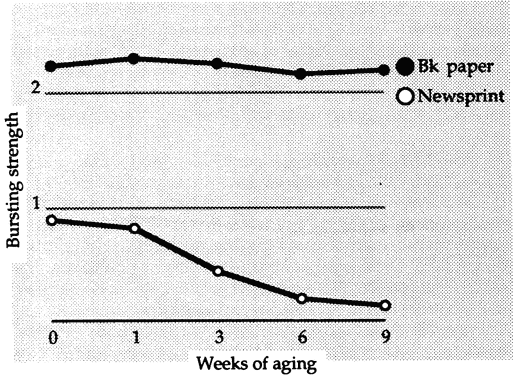

A graph that showed groundwood aging more rapidly than freesheet was printed in the October issue of this Newsletter, to show that the impermanence of groundwood paper has been demonstrated not only in daily experience but also in research settings. (At the ISR workshop in July, reported in the July issue, evidence for groundwood impermanence was dismissed as "anecdotal" by one or two industry scientists. The fact that newspapers have been deteriorating rapidly ever since they started being made of groundwood 125 years ago was attributed to a lower pH.)
The graph below is presented as an example of evidence that is available in the literature. It is based on data from the same study as the one published in July: "The Effects of Pollution on Deacidified Paper," by Floréal Daniel, Françoise Flieder and Françoise LeClerc, Restaurator 11 #3, 179-207, 1990. Data for the earlier graph were taken from graphs on p. 199, and for this graph, from p. 200. Both graphs show values only for the two control papers, which like the test sheets were aged in polluted atmospheres (13 ppm SO2 and4 ppm NO2) at 28°C and 90% RH. The papers were 1) rosin-sized, clay-coated book paper and 2) newsprint (60% groundwood); both had an initial pH of 5.

Fig. 1. Effect of pollution on strength of newsprint and freesheet.